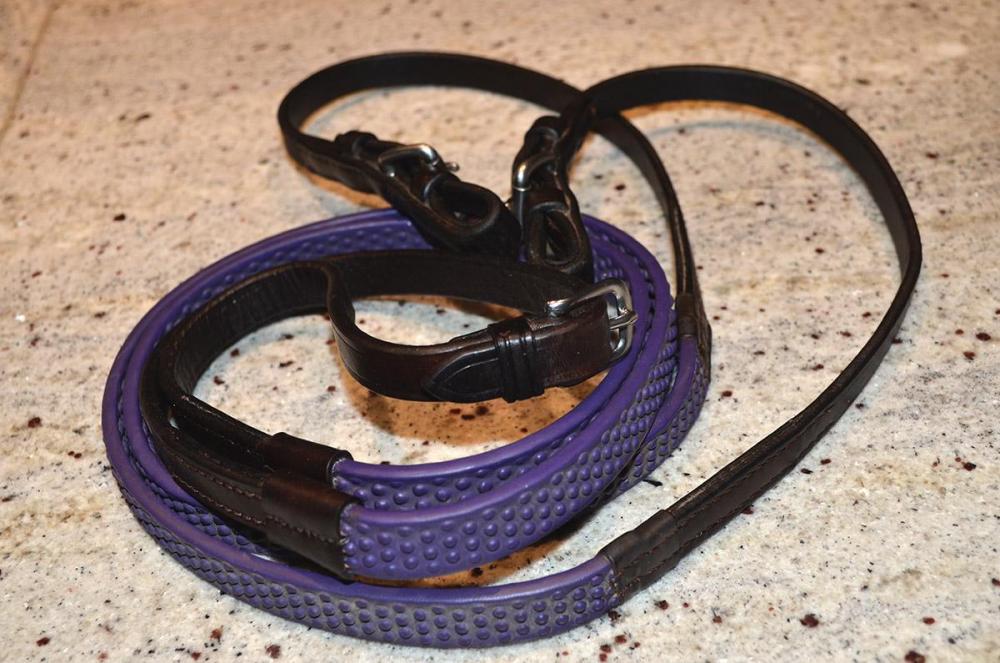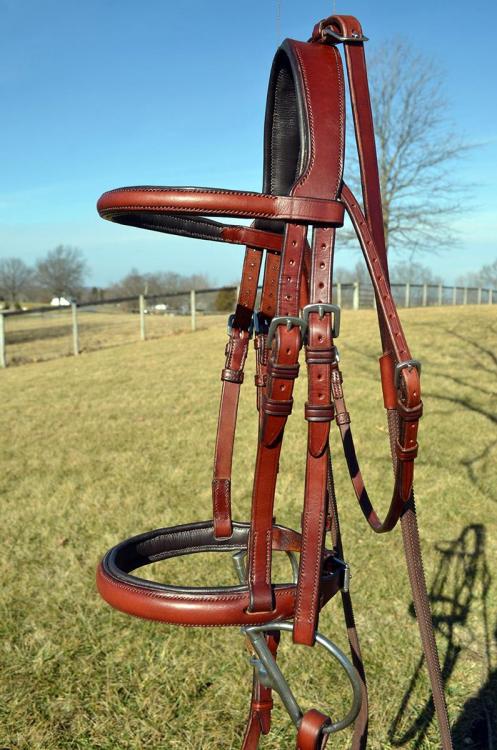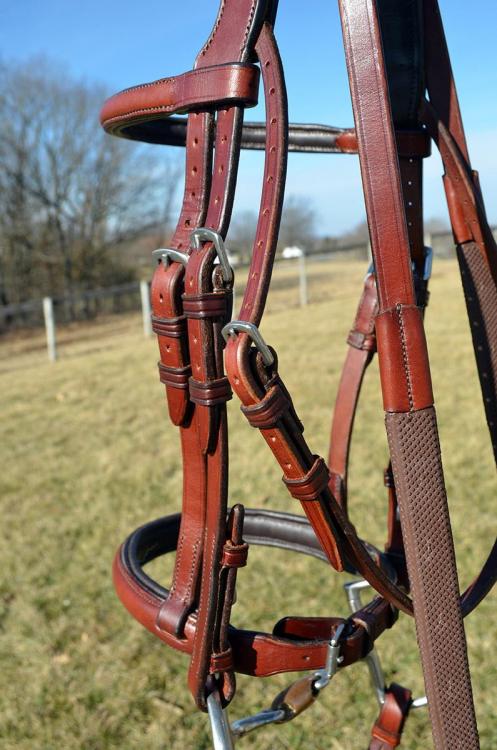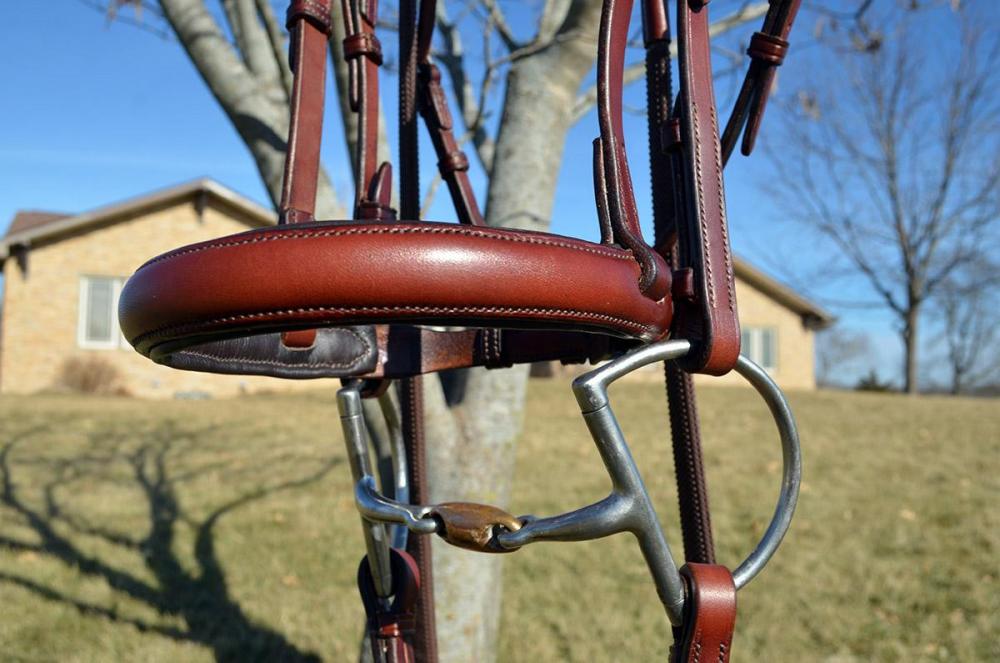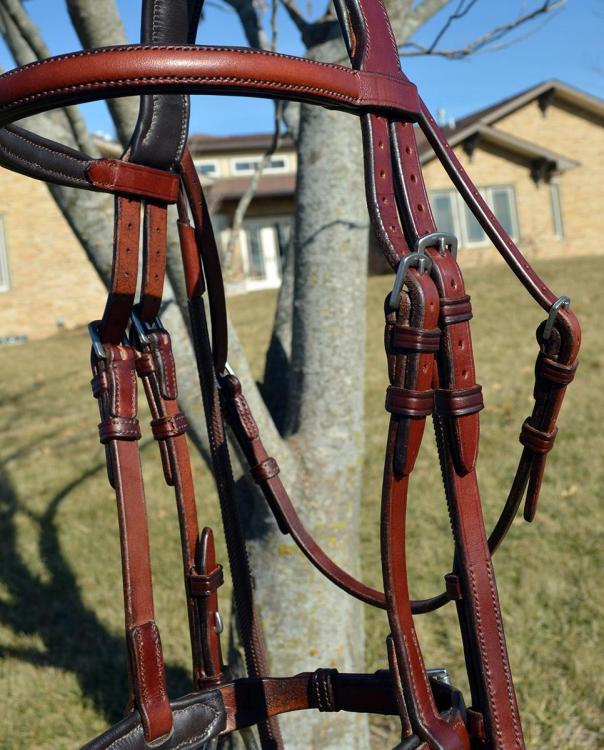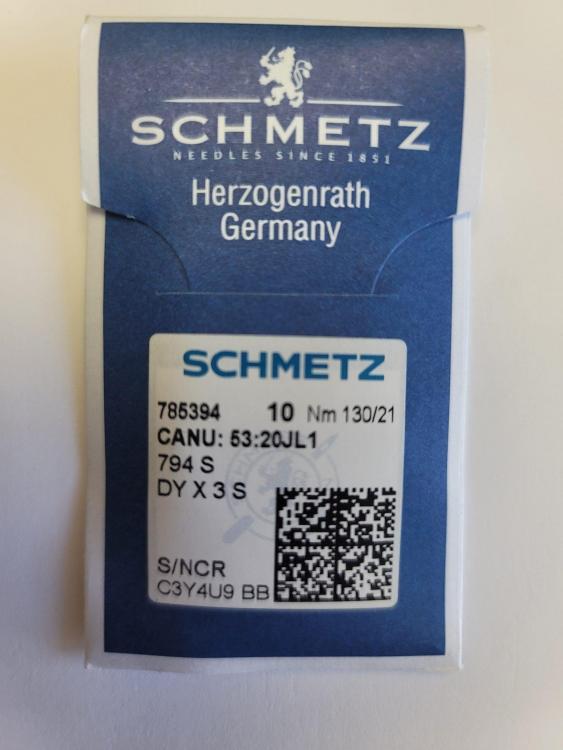-
Posts
1,282 -
Joined
-
Last visited
Content Type
Profiles
Forums
Events
Blogs
Gallery
Everything posted by TomE
-
"I only want to see you riding in the purple reins." Couldn't resist. Yesterday's project was replacing the buckle ends of a friend's reins. Torn in two. Got a pretty good color match with existing - that's dark brown Fenice Colorfast dye. These rubber grips are nylon webbing coated with rubber. A piece of web inserts into a split in the leather strap and is sewn in place. I prefer grips that slide over a continuous leather strap. The cuffs covering the junction of leather strap and rubber grips are a little different than existing but I think they'll pass inspection.
- 2 replies
-
- bridle leather
- reins
-
(and 1 more)
Tagged with:
-
Thanks! I appreciate it. Thank you. Staying focused on halters, bridles, and reins until I master these items. Thinking about future projects to use leftover shoulders and bellies of 9-11 oz bridle leather sides.
-
-
Interesting article and business. Best of luck to you. I think @Mulesaw would relate to doing leathercraft at sea.
- 7 replies
-
- south sound
- leather crafter
- (and 6 more)
-
Beautiful work on the knives and sheaths. Thanks for sharing.
-
I burnish thin leather (~3 oz) by laying it flat on a slick surface like a cutting mat and rubbing with a folded piece of canvas. Turn the leather over and work the top and bottom of the edge until it looks right. I also use a power burnisher covered with a canvas sleeve. Use light pressure and support the thin leather with your finger tips. I rub the edge on a piece of canvas wetted with water/saddle soap to moisten the edge then power burnish. I typically don't use gum trag because I burnish before dyeing the edge then do another round of burnishing after dyeing.
-
Pergamena Tannery specializes in veg tanned, lightweight leathers including goat. https://www.pergamena.net/
-
I'm thinking I can make a leash and collar out of cow hide that won't break with the amount of force a person can exert on the end of a leash. If you're tying the animal then I would want it to break at some point or risk injury to the animal's back or neck. At least that's how we think about leather horse tack.
-
The Cobra Class 4 (or Cowboy CB4500) really shines when sewing 12-30 oz of material, but it's not practical for 6 oz or less. I have a Class 4 and hand sew about half of my projects. Sometimes it's easier to sew by hand than to configure a project for machine sewing. I have the Cobra burnisher and use the sanding drum more than the wooden slicker. The sander is handy for leveling up edges made from multiple layers. I covered the burnisher with a canvas sleeve and it's handy for the initial burnishing of long straps like reins, but I still finish the edges by hand to get a smoother finish. My advice, as someone who recently returned to leathercraft after a ~50 yr hiatus, is at first to focus on a few types of projects using hand tools. Learn how to use and maintain the tools while figuring out how a machine would enhance your productivity or enjoyment. As we saw in the Terminator movies, machines have their limits and don't always carry the day.
-
Better yet, could train an AI algorithm to value leather goods based on pictures/prices of items posted online. We could use the app could to set the price of our goods. I'll match any advertised price, etc. ...Am I on the right track?
-
Better days ahead in MO. Stayed above 0 deg F last night and the wind has moderated. Power stayed on. Horses are doing fine in the cold, eating lots of hay and some are blanketed. Predicting 60 deg. F and rain later next week. Merry Christmas and happy holidays everyone!
-
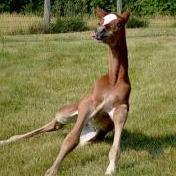
Couple of belts
TomE replied to Nooj's topic in Purses, Wallets, Belts and Miscellaneous Pocket Items
Those belts look great to me! What types of leather and finish did you use? I know what you mean about the time involved. It takes me 20 hrs to make a bridle and I don't feel comfortable charging what I think my time is worth. I could cut corners (e.g., simplify the design and machine sew) but I'd rather do the job in a way that builds my skills and satisfies my standards. I have the luxury of treating this as a hobby while gaining more experience and building a reputation. -
Highly skilled work right there. I'm interested in the modified awl. Heated and bent in a curve? How long? How do you sharpen it?
-
Thank you, @Basically Bob. I'm getting faster but I am basically a 2-trick pony -- bridles and halters.
-
Well done! Handsome bag and pretty fabric for the liner. The medallion makes it even more special.
-
Thank you. Yes, she's cute but even better she is a highly skilled craftsperson who teaches the traditional methods of saddlery/harness-makng. We use biothane for every day halters. I buy them from 2 Horse Tack bc their stainless hardware is first rate and I wouldn't save much buying the materials and making them.
-
Thank you! The pad is 1/8" thick neoprene wrapped with 3-4 oz. chrome tanned leather. The pad is assembled with glue then glued to the crown/headpiece and sewn. Can see the process on JH Leather Youtube videos for padded dog collars.
-
I would begin with a light coating of 100% neatsfoot oil (not compound) and let that soak in for a day or two. I would then condition, working the conditioner in with fingers. If you don't make your own, some popular conditioners are Bick's 4, Blackrock, Aussie, and Lederbalsam. The key to longevity is to maintain the leather during use. For tack, that includes regular cleaning with saddle soap, applying conditioner as needed, and periodically oiling (but not over doing it).
-
You have 2 leather resources in PA. Wickett and Craig of America, and Keystone Leather. I would call them. I previously mentioned Hermann Oak Leather Co, which is another well respected tannery in Saint Louis with good customer service.
-
Saddle skirting (unsplit hide) is typically up to 16 oz thickness. The Hermann Oak Leather Co (tannery) is very helpful and could advise you based on your specifications. If you're new to leather, download the Springfield Leather Co catalog and read the introductory material about choosing leather for your project.
-
I think the problem is biological; there are no 20 oz cows.
-
Just ordered size #21 needles from Leather Machine Co for my Cobra Class 4. Previously hadn't seen anything smaller than size #23 in 794S. Going to try lighter threads with the adjustments described in @Wizcrafts blog. https://www.rw-leatherworks.com/blog/2019/02/dumbing-down-a-cowboy-cb4500-cobra-class-4-or-similar-harness-stitcher.html.
-
Beautiful work! I'd need new spectacles for this realm. What is the tool used for creasing?
-
That's a work of art! Look forward to seeing more of your creations.



